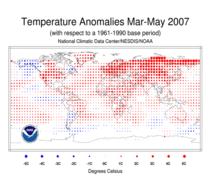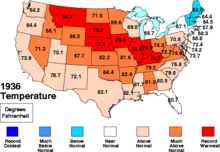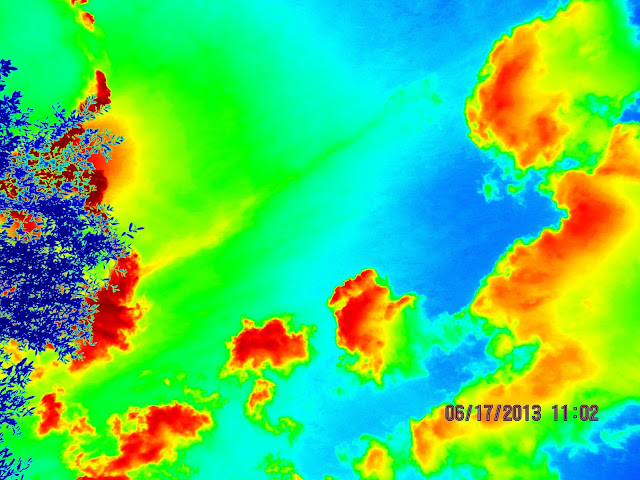Hi Everybody!!
I had to venture out in this heat today, so I made a quick trip by the Garden Shop in search of Butterflies. This is Jessica. She is the Manager of the Shop and caretaker of all the plants. She reports there have not been many butterflies, nothing like last year. Your infostudy from Wikipedia is on the topic Heat Wave!
What flowers are blooming in this 100 degree heat? Jessica says: Walk this Way!!!
Enjoy these Hot Bloomers!
Hibiscus
Crape Myrtle
Bush Rose
Pink Mallow
Northern Cardinal
Wild Rose
Crape Myrtles
Pin cushion
Double Orange Daylily loves this Heat!
http://en.wikipedia.org/wiki/Heat_wave
Heat wave
From Wikipedia, the free encyclopedia
A heat wave is a prolonged period of excessively hot weather, which may be accompanied by highhumidity. While definitions vary,[1] a heat wave is measured relative to the usual weather in the area and relative to normal temperatures for the season. Temperatures that people from a hotter climate consider normal can be termed a heat wave in a cooler area if they are outside the normal climatepattern for that area.[2] The term is applied both to routine weather variations and to extraordinary spells of heat which may occur only once a century. Severe heat waves have caused catastrophic crop failures, thousands of deaths from hyperthermia, and widespread power outages due to increased use of air conditioning.
Definitions[edit]
The definition recommended by the World Meteorological Organization is when the daily maximum temperature of more than five consecutive days exceeds the average maximum temperature by 5 °C (9 °F), the normal period being 1961–1990.[3]
- A period of abnormally and uncomfortably hot and usually humid weather.
- To be a heat wave such a period should last at least one day, but conventionally it lasts from several days to several weeks. In 1900, A. T. Burrows more rigidly defined a “hot wave” as a spell of three or more days on each of which the maximum shade temperature reaches or exceeds 90 °F(32.2 °C). More realistically, the comfort criteria for any one region are dependent upon the normal conditions of that region.

Temperature anomalies, March to May, 2007
In the Netherlands, a heat wave is defined as period of at least 5 consecutive days in which the maximum temperature in De Bilt exceeds 25 °C (77 °F), provided that on at least 3 days in this period the maximum temperature in De Bilt exceeds 30 °C (86 °F). This definition of a heat wave is also used in Belgium andLuxembourg.
In Denmark, a heat wave is defined as a period of at least 3 consecutive days of which period the average maximum temperature across more than fifty percent of the country exceeds 28 °C (82.4 °F), while in Sweden, a heat wave is defined as at least 5 days in a row with a daily high exceeding 25 °C (77.0 °F).[5]
In the United States, definitions also vary by region; however, a heat wave is usually defined as a period of at least two or more days of excessively hot weather.[6] In the Northeast, a heat wave is typically defined as three consecutive days where the temperature reaches or exceeds 90 °F (32.2 °C), but not always as this ties in with humidity levels to determine a heat index threshold.[7] The same does not apply to drier climates. A heat storm is a Californian term for an extended heat wave. Heat storms occur when the temperature reaches 100 °F (37.8 °C)for three or more consecutive days over a wide area (tens of thousands of square miles). The National Weather Service issues heat advisories and excessive heat warnings when unusual periods of hot weather are expected.
In Adelaide, a heat wave is defined as five consecutive days at or above 35 °C (95 °F), or three consecutive days at or over 40 °C (104 °F).
How they occur[edit]

High pressure aloft traps heat near the ground, forming a heat wave
Heat waves form when high pressure aloft (from 10,000–25,000 feet (3,000–7,600 metres)) strengthens and remains over a region for several days up to several weeks. This is common in summer (in both Northern and Southern Hemispheres) as the jet stream 'follows the sun'. On the equator side of the jet stream, in the middle layers of the atmosphere, is the high pressure area.
Summertime weather patterns are generally slower to change than in winter. As a result, this mid-level high pressure also moves slowly. Under high pressure, the air subsides (sinks) toward the surface. This sinking air acts as a dome capping the atmosphere.
This cap helps to trap heat instead of allowing it to lift. Without the lift there is little or no convection and therefore little or no convective clouds (cumulus clouds) with minimal chances for rain. The end result is a continual build-up of heat at the surface that we experience as a heat wave.[9]
In the Eastern United States a heat wave can occur when a high pressure system originating in the Gulf of Mexico becomes stationary just off the Atlantic Seaboard (typically known as a Bermuda High.) Hot humid air masses form over the Gulf of Mexico and the Caribbean Sea while hot dry air masses form over the desert Southwest and northern Mexico. The SW winds on the back side of the High continue to pump hot, humid Gulf air northeastward resulting in a spell of hot and humid weather for much of the Eastern States.[10]
In the Western Cape Province of South Africa, a heat wave can occur when a low pressure offshore and high pressure inland combine to form a Bergwind. The air warms as it descends from the Karoo interior, and the temperature will rise about 10 °C from the interior to the coast. Humidities are usually very low, and the temperatures can be over 40 °C in summer. The highest official temperatures recorded in South Africa (51.5 °C) was recorded one summer during a bergwind occurring along the Eastern Cape coastline.[11][12]
Caution
Extreme Caution
Danger
Extreme Danger
The Heat Index (as shown in the table above) is a measure of how hot it feels when relative humidity is factored with the actual air temperature. Hyperthermia, also known as heat stroke, becomes commonplace during periods of sustained high temperature and humidity. Sweating is absent from 84%–100% of those affected. Older adults, very young children, and those who are sick or overweight are at a higher risk for heat-related illness. The chronically ill and elderly are often taking prescription medications (e.g., diuretics, anticholinergics, antipsychotics, and antihypertensives) that interfere with the body's ability to dissipate heat.[16]
Heat edema presents as a transient swelling of the hands, feet, and ankles and is generally secondary to increased aldosterone secretion, which enhances water retention. When combined with peripheral vasodilation and venous stasis, the excess fluid accumulates in the dependent areas of the extremities. The heat edema usually resolves within several days after the patient becomes acclimated to the warmer environment. No treatment is required, although wearing support stocking and elevating the affected legs with help minimize the edema.
Heat rash, also known as prickly heat, is a maculopapular rash accompanied by acute inflammation and blocked sweat ducts. The sweat ducts may become dilated and may eventually rupture, producing small pruritic vesicles on an erythematous base. Heat rash affects areas of the body covered by tight clothing. If this continues for a duration of time it can lead to the development of chronic dermatitis or a secondary bacterial infection. Prevention is the best therapy. It is also advised to wear loose-fitting clothing in the heat. However, once heat rash has developed, the initial treatment involves the application of chlorhexidinelotion to remove any desquamated skin. The associated itching may be treated with topical or systemic antihistamines. If infection occurs a regimen ofantibiotics is required.
Heat cramps are painful, often severe, involuntary spasms of the large muscle groups used in strenuous exercise. Heat cramps tend to occur after intense exertion. They usually develop in people performing heavy exercise while sweating profusely and replenishing fluid loss with non-electrolyte containing water. This is believed to lead tohyponatremia that induces cramping in stressed muscles. Rehydration with salt-containing fluids provides rapid relief. Patients with mild cramps can be given oral .2% salt solutions, while those with severe cramps require IVisotonic fluids. The many sport drinks on the market are a good source of electrolytes and are readily accessible.
Heat syncope is related to heat exposure that produces orthostatic hypotension. This hypotension can precipitate a near-syncopal episode. Heat syncope is believed to result from intense sweating, which leads to dehydration, followed by peripheral vasodilation and reduced venous blood return in the face of decreased vasomotor control. Management of heat syncope consists of cooling and rehydration of the patient using oral rehydration therapy(sport drinks) or isotonic IV fluids. People who experience heat syncope should avoid standing in the heat for long periods of time. They should move to a cooler environment and lie down if they recognize the initial symptoms. Wearing support stockings and engaging in deep knee-bending movements can help promote venous blood return.
Heat exhaustion is considered by experts to be the forerunner of heat stroke (hyperthermia). It may even resemble heat stroke, with the difference being that the neurologic function remains intact. Heat exhaustion is marked by excessive dehydration and electrolyte depletion. Symptoms may include headache, nausea, and vomiting, dizziness, tachycardia, malaise, and myalgia. Definitive therapy includes removing patients from the heat and replenishing their fluids. Most patients will require fluid replacement with IV isotonic fluids at first. The salt content is adjusted as necessary once the electrolyte levels are known. After discharge from the hospital, patients are instructed to rest, drink plenty of fluids for 2–3 hours, and avoid the heat for several days. If this advice is not followed it may then lead to heat stroke.
One public health measure taken during heat waves is the setting-up of air-conditioned public cooling centers.
2010–Present[edit]
- The Northern Hemisphere summer heat wave of 2010 affected many areas across the Northern Hemisphere, especially parts of Northeastern China and European Russia.
- Starting in May 2010, records were being set. On 26 May, at Mohenjo-daro, Sindh province in Pakistan a national record high temperature of 53.5 °C(128.3 °F) occurred.
- In June 2010, Eastern Europe experienced very warm conditions. Ruse, Bulgaria hit 36.6 °C (97.9 °F) on the 13th making it the warmest spot in Europe. Other records broken on the 13th include Vidin, Bulgaria at 35.8 °C (96.4 °F), Sandanski, Bulgaria hitting 35.5 °C (95.9 °F), Lovech and Pazardzhik, Bulgaria at 35.1 °C (95.2 °F) as well as the capital, Sofia, hitting 33.3 °C (91.9 °F). The heat came from the Sahara desert and was not associated with rain. This helped the situation with high water levels in that part of the continent.[52] On the 14th, several cities were once again above the 35 °C (95 °F)mark even though they did not break records. The only cities in Bulgaria breaking records were Musala peak hitting 15.2 °C (59.4 °F) and Elhovo hitting35.6 °C (96.1 °F).[53] On the 15th, Ruse, Bulgaria peaked at 37.2 °C (99.0 °F). Although it was not a record, this was the highest temperature recorded in the country. Five Bulgarian cities broke records that day: Ahtopol hit 28.6 °C (83.5 °F), Dobrich was 33.8 °C (92.8 °F), Karnobat hit 34 °C (93 °F), Slivenhit 35 °C (95 °F) and Elhovo recorded 36.1 °C (97.0 °F).[54]
- From July 4 to July 9, 2010, the majority of the American East Coast, from the Carolinas to Maine, was gripped in a severe heat wave. Philadelphia, New York, Baltimore, Washington, Raleigh, and even Boston eclipsed 100 °F (38 °C). Many records were broken, some of which dated back to the 19th century, including Wilmington, Delaware's temperature of 103 °F (39 °C) on Wednesday, July 7, which broke the record of 97 °F (36 °C) from 1897. Philadelphia and New York eclipsed 100 °F (38 °C) for the first time since 2001. Fredrick, Maryland, and Newark, New Jersey, among others topped the century mark (37.8 Celsius) for four days in a row.[55]
- The UK declared a heatwave, MetOffice Level 2/4, on 9 July 2010 for South East England and East Anglia. This was after temperatures reached 31.0 degrees Celsius in London and night-time temperatures levelled around 21 degrees Celsius.
- The 2011 North American heat wave brought record heat to the Midwestern United States, Eastern Canada, and much of the Eastern Seaboard.
- A record-breaking heat wave hit Southwestern Asia in late July and early August 2011, with temperatures in Iraq exceeding 120 °F (49 °C),[56] and an "asphalt-melting, earth-parching, brain-scrambling heat of midsummer" in Tbilisi, Georgia.[57] The Iraqis were further challenged by pressure to fast duringRamadan, despite heat of 124 °F (51 °C) in Baghdad and 126 °F (52 °C) in Diwaniya on 4 August.[56] The extreme heat inspired conspiracy theories of the government corruption in Iraq and retaliation from the United States government;[56] and, in Georgia, the Apocalypse, mutant locusts caused byChernobyl, snakes imported by unseen enemies, and sun spots.[57]
- Most parts of the United Kingdom experienced an Indian summer between September and October 2011. The heat wave resulted in a new record high temperature for October at 30°C.[58]

Land surface temperatures of March 8–15, 2012. Land surface temperatures are distinct from the air temperatures that meteorological stations typically measure.
- In March 2012, one of the greatest heat waves was observed in many regions of North America. First very warm air pushed northward west of the Great Lakes region, and subsequently spread eastward. This air mass movement was propelled by an unusually intense low level southerly jet that stretched from Louisiana to western Wisconsin. Once this warm surge inundated the area, a remarkably prolonged period of record setting temperatures ensued.[59] NOAA's National Climate Data Center reported that over 7000 daily record high temperatures were broken over the U.S. from 1 March thru 27 March.[59] In some places the temperature exceeded 30 °C (86 °F) with anomalies up to +22°C. Temperature records across much of southern Canada were also demolished.[60]
- In March, 2012, the United Kingdom experienced a heat wave with temperature anomalies of +10 °C in many places.[61]
- In late June 2012, much of North America began experiencing a heat wave, as heat spread east from theRocky Mountains. During the heat wave, the June 2012 North American derecho caused violent storms that downed trees and power lines, leaving 3 million people in the eastern U. S. without power on June 30.[62] The heat lasted until Mid-August in some parts of the country.
- The Australian summer of 2012-2013, known as the Angry Summer or Extreme Summer, resulted in 123 weather records being broken over a 90-day period, including the hottest day ever recorded for Australia as a whole, the hottest January on record, the hottest summer average on record, and a record seven days in row when the whole continent averaged above 39° C.[63][64] Single-day temperature record were broken in dozens of towns and cities, as well as single-day rainfall records, and several rivers flooded to new record highs.[63] From Dec 28th, 2012 through at least January 9th, 2013 Australia has faced its most severe heatwave in over 80 years, with a large portion of the nation recording high temperature reading above 40°C to 45°C or greater in some areas, a couple spots have also neared 50°C. This extreme heat has also resulted in a 'flash' drought across southern and central areas of the country and has sparked several massive wildfires due to periodic high winds.
The following images are skyscapes over the Garden Shop in town.
They have the added Picasa Effect of Heat Map to show off the Hot Clouds!
Cool Pics!
...this is brendasue signing off from Rainbow Creek. See You next time! Please consider this summer is likely to break many heat records. Prepare yourself! Sending Love out to everybody!! Stay Cool-
Chill Out!
O+O




















































































Buy parrots online | Parrots for sale | Parrot and Eggs Breeder's
ReplyDeleteContact Us : birdsfarmsales@gmail.com | Call/ Text +1 646-535-7719
We are license to export parrots and eggs to USA, Europe, Asia, United Arab Emirates, Oceania, Middle East. Our parrots are transported in secured cages and live parrots boxes. We also have available fertile parrots eggs for sale.
Now available in stock are the following live parrots and birds for sale. We also have chicks from 1 day old up to 60 days old available in stock. Our parrots are free from the bird flu and vet checked. They are tamed and hand raised. They can serve as good pets and companions.
Contact Us:
Email us :birdsfarmsales@gmail.com
Call/ Text +1 646-535-7719
Buy African Grey Parrots online
Buy Blue & Gold Macaw online,
Buy Hyacinth Macaws online,
Buy Cockatoo Parrots online,
Buy Toucans online,
Buy Caique Parrots online,
Buy Conures online,
Buy Falcon Birds online,
Buy Amazon parrots online,
Buy African Grey parrot eggs
Buy Hyacinth macaw eggs,
Buy Black palm cockatoo eggs,
Buy Blue and gold macaw eggs,
Buy Citron cockatoo eggs,
Buy Gang gang cockatoo eggs,
Buy Goffin cockatoo eggs,
Buy Green wing macaw eggs,
Buy Harlequin macaw eggs,
Buy Hyacinth macaw eggs,
Buy Major Mitchell cockatoo eggs,
Buy Rose breasted cockatoo eggs,
Buy Scarlet macaw eggs,
Buy Umbrella Cockatoo eggs,
Buy Scarlet Macaw eggs,
Buy Sollomons Island Eclectus eggs,
Buy Amazon Parrot eggs,
Buy Finches eggs ,
Buy Falcons eggs ,
Buy Canaries eggs,
Buy Conures eggs,
Buy Electus Parrot eggs,
Buy Senegal Parrot eggs,
Buy Parakeets eggs,
Buy Cockatiels eggs,
Buy Hawk Headed Parrots,
Buy Toco Toucan eggs,
Buy Conures eggs,
All our eggs are collected from very healthy birds in our Aviary , candle tested and 100% confirmed fertile for hatching healthy babies . We are now taking orders from those who are interested in raising up their own baby birds from the eggs stage.
Its fun hatching your own baby(ies) from eggs and we will assist you in any way to hatch out your birds successfully.
Contact Us:
Email us :birdsfarmsales@gmail.com
Call/ Text +1 646-535-7719